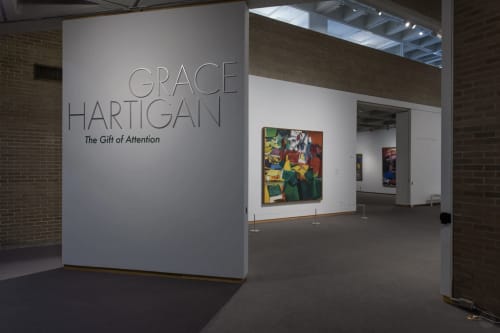The postwar American painter Grace Hartigan’s work is experimental in ways that defied critic Clement Greenberg’s dicta, wherein the modern artwork is to be abstract and about its own medium specificity—for a painting, flatness, for example. Hartigan’s work is, on the contrary, both representational and abstract, with wild forays into lithography, collage, all the while, communing with poetry. As such, her work kicks the door wide open on this well researched period of artistic activity.
Often quoted is Hartigan’s statement that rather than inviting the “spectator to walk into my canvases. I want a surface that resists, like a wall, not opens, like a gate.” But what did her work do, other than resist? Grace Hartigan: The Gift of Attention, currently at the North Carolina Museum of Art, focuses on Hartigan’s relationship to the New York School poets, including Frank O’Hara—whose work and wit provided a wellspring of support for her in a man’s world— as well as Daisy Aldan, James Schuyler, and Barbara Guest—a friend and colleague with whom Hartigan worked in a call-and-response manner. Indeed, many of the most impressive paintings in the show are inspired by Guest’s poetry. For example, Hartigan’s gorgeous Snow Angel (1960) is in dialogue with Guest’s poem of the same title, which concerns the coming of winter, with grey rising and the onset of “the first Angel of snow / tomorrow in the outraged sky / his form.” A large area on the right upper corner of the painting shows shifting fields of blue, grey, and smoky taupe overtaken by cloudy billows blowing over from the left, with earthy reds and greens below. A heavy black line moves across the scene like a crow on the plains.
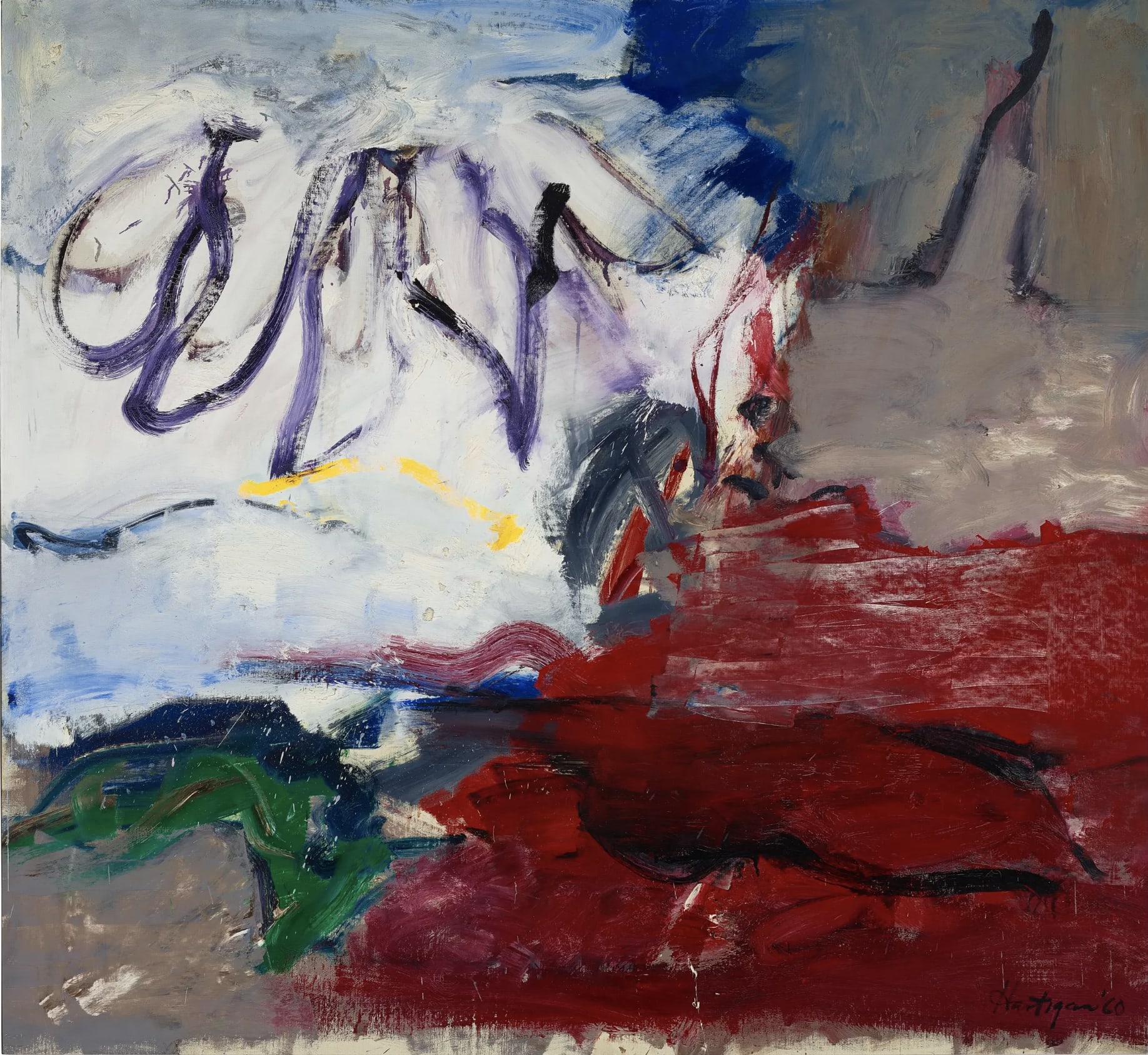
Grace Hartigan, Snow Angel, 1960. Oil on canvas, 69 × 75 ¼ in.
© 2021 Christie’s Images.
Courtesy the artist and North Carolina Museum of Art.
Along with forty-five works by Hartigan, this exhibition includes the poems that inspired her and archival matter—such as copies of Folder journal, which Hartigan made screen prints for—from 1952 to 1968. During this exciting period, Hartigan worked in diverse media and collaborated intensely with a community of artists and poets who coupled in equally diverse arrangements—lesbian, gay, gay and straight (and Hartigan, while straight, described her relationship with the gay O’Hara as a love affair). Curator Jared Ledesma describes Hartigan’s community as queer and, indeed, these artists were experimenting with fluidity in both sex and art long before the concepts gained cultural currency. In this light, Hartigan’s paintings can be reappraised. Of her painting Black Crows (Oranges No. 1) (1952), for example, which includes phrases from O’Hara’s poem (“the brimstone odor of your stars sneers at our horoscope”), the viewer sees the painting stage the mutability the artists lived as the words melt into the canvas.
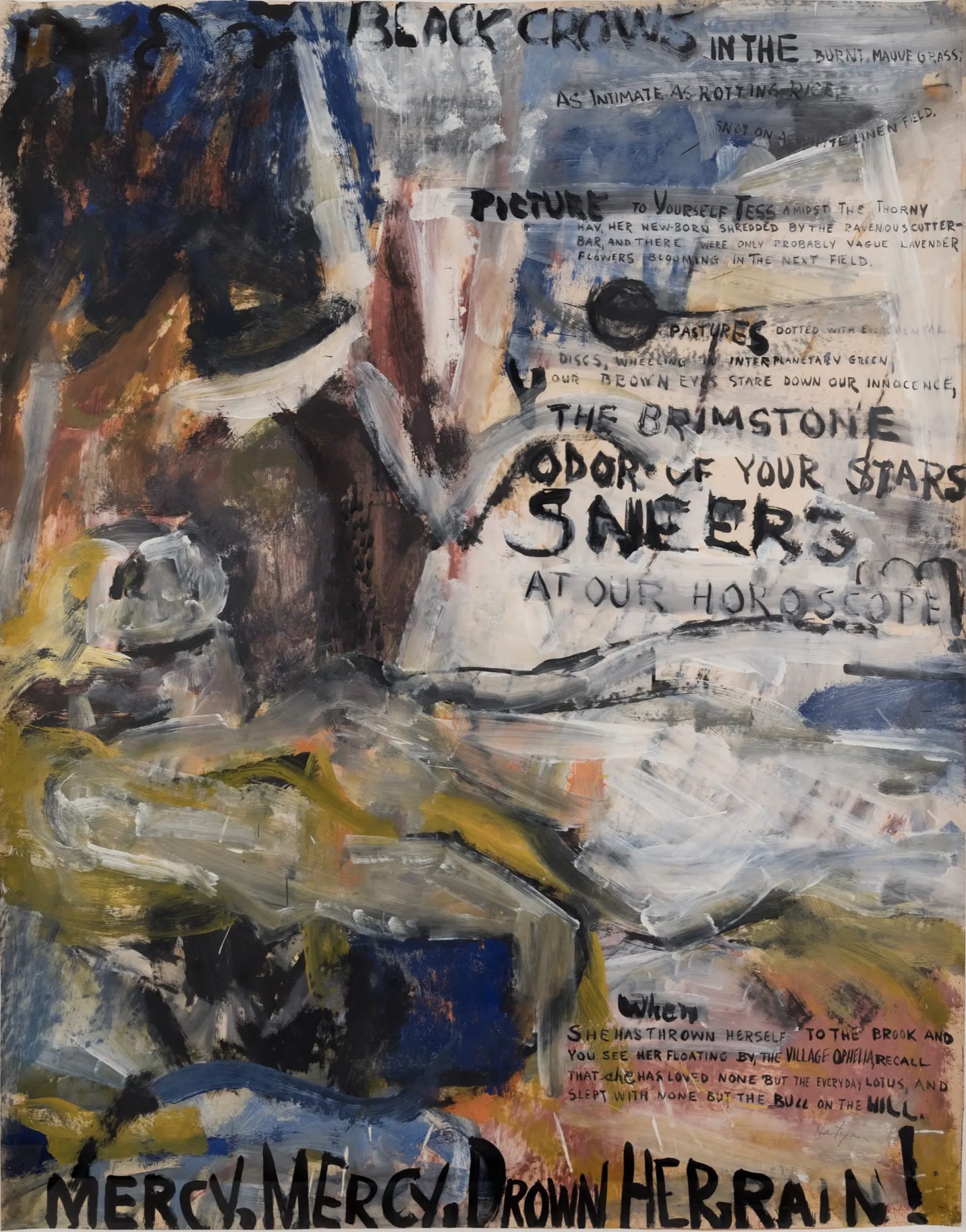
Black Crows (Oranges No. 1)
Photo: Nicholas Ostness.
At times Hartigan’s works seem to rebuff Greenberg by showing that one need not choose between representation and abstraction (and she was promptly dropped from his stable of preferred artists). For example, The Persian Jacket (1952), works equally well as an abstract painting and a figurative work, depending how you look at it. As well, it’s interesting to trace how this immensely somber painting, quickly bought by the Museum of Modern Art (some say at Greenberg’s behest), translated to a page-sized screen print on paper in 1953, included in Folder journal #1. Here, the heaviness is lost, and the effect is light and comical.
Despite such playful extrapolations, Hartigan’s artworks are self-supporting. They include all the elements a viewer needs to unpack the image in the image. For example, Bray (1958)—possibly a scene from Ireland where Hartigan visited, as the title suggests, but also reading like a still life—shows mustard yellow ovals with plush red squiggles wrapping the forms, while, below, an ultramarine passage thrusts into an orange rectangle that floats over a glistening ultramarine surface. A burnt chocolate lump leans against a dusty clam shape, shown split with its maroon interior threatening to ooze.
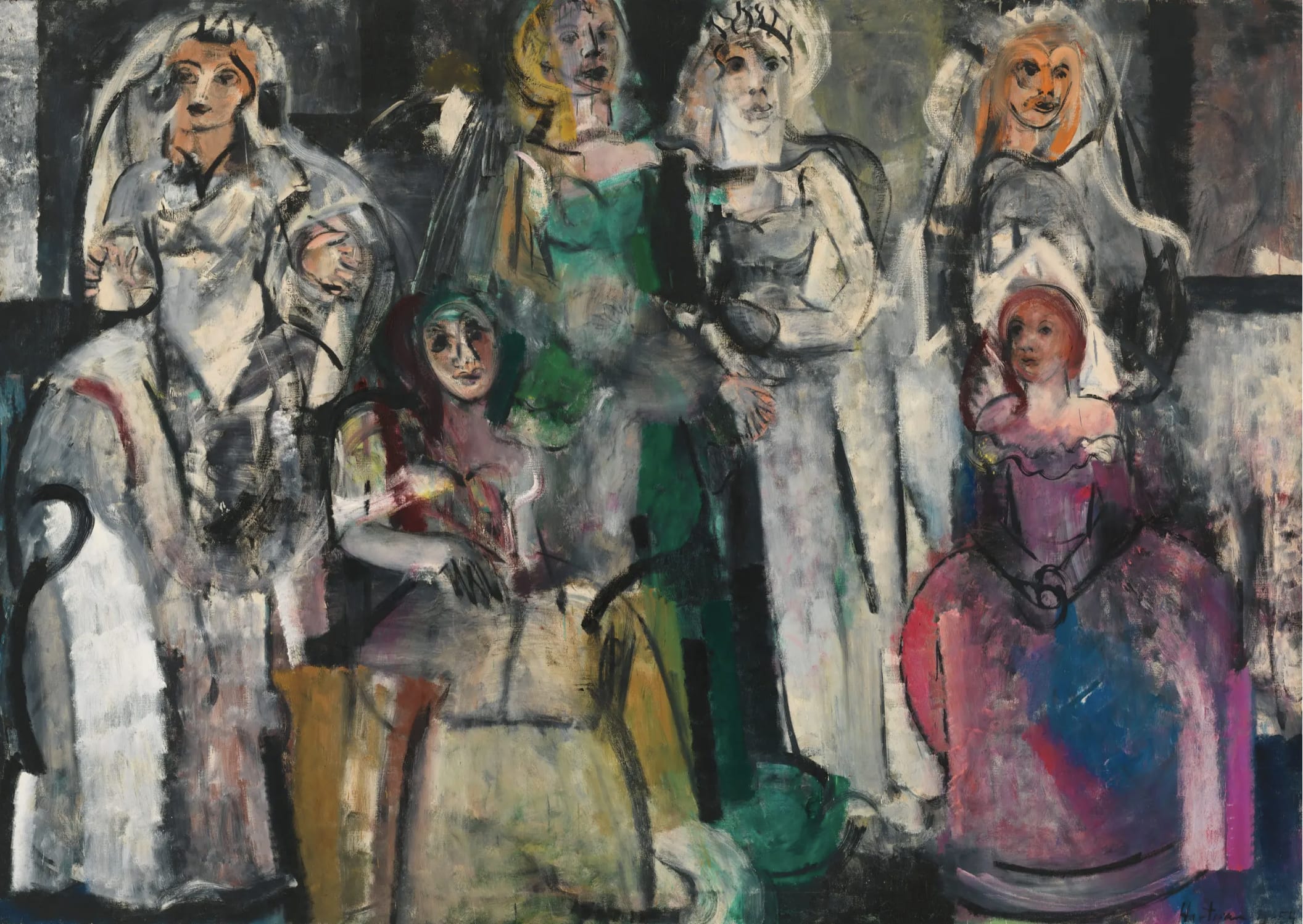
Grace Hartigan, Grand Street Brides, 1954. Oil on canvas, 72 ½ × 102 ⅜ inches. © Whitney Museum of American Art/Licensed by Scala/Art Resource. Courtesy the artist and North Carolina Museum of Art.
Throughout, Hartigan’s black lines—what James Schuyler aptly described as “the generous amplitude which is first nature to her work”—are combined with painterly swathes of shifting color, over which washes, smudges, and squiggles make these lines, forms and fields imperfect, ephemeral. There are references to Paul Cézanne, Francisco Goya, Pablo Picasso, and Henri Matisse, and classical genres—particularly the still life and landscape. “Willed art in a nest of worlds,” wrote O’Hara in his 1952 “Poem to a Painter,” dedicated to Hartigan.
The exhibition links Hartigan’s painterly style to her community of poets by underscoring themes that crossed over, such as masking—as in passing as straight, as were many of the homosexual artists when presenting in public, and referenced in Hartigan’s Grand Street Brides and Masquerade (both 1954), both in the exhibition—and real life—as in snippets of casual speech and conversation for the poets; for Hartigan, recognizable figures that, at times, lean toward kitsch. In Interior with Mexican Doll (1955), for example, a blaring orange doll lies smack dab in the painterly field, a garish pop reference that shatters the cool interior of blues, greens, reds, yellows, and whites, and contrasts starkly with the sober mask floating above it.
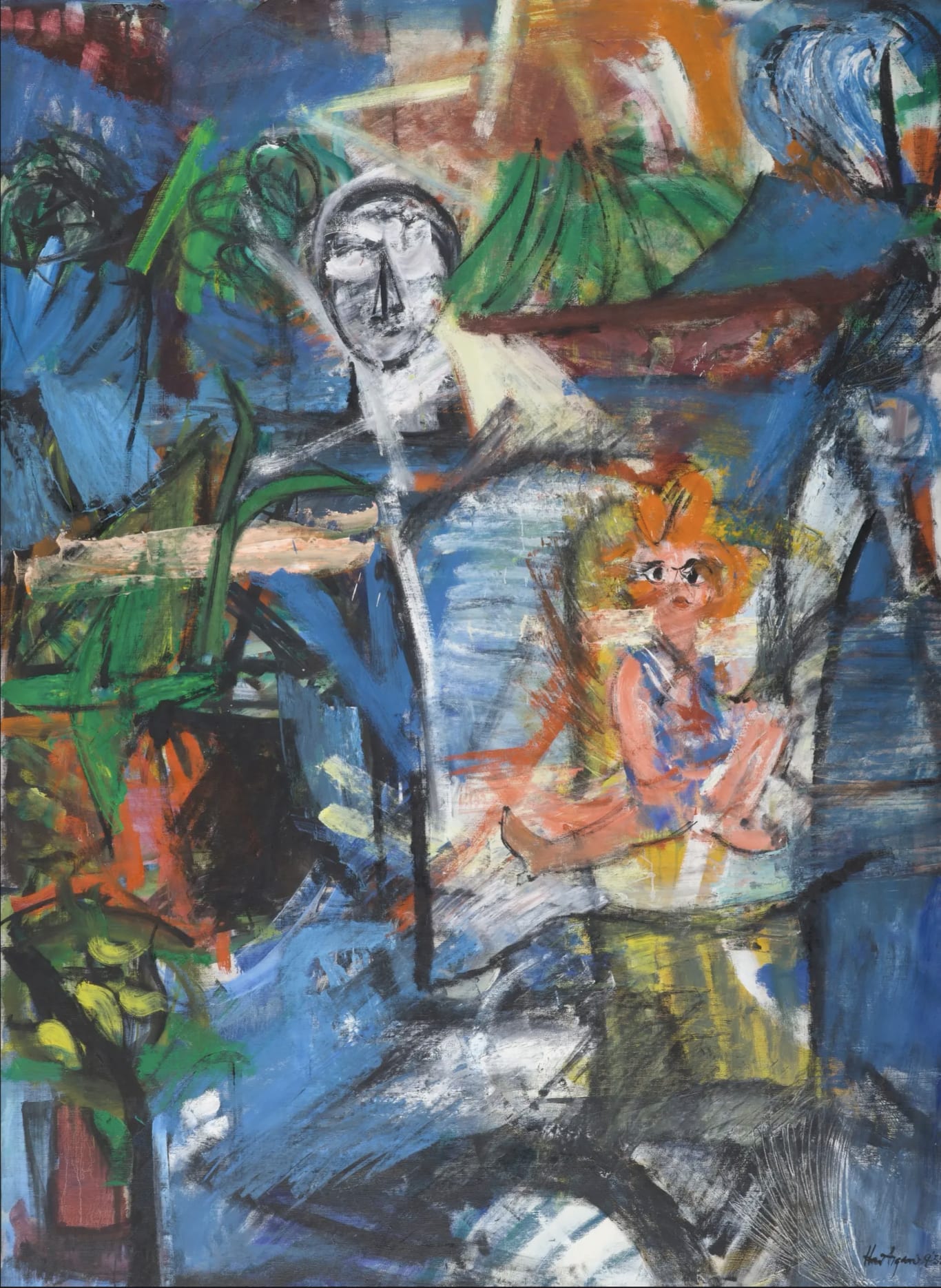
Grace Hartigan, Interior with Mexican Doll, 1955. Oil on canvas, 80 ½ × 58 ½ inches. Courtesy the artist and North Carolina Museum of Art.
This exhibition doesn’t resolve the puzzle of this painting, nor does it clean up the story of this working-class New Jersey artist who burst onto the scene exhibiting under the name of George. Her life, as her work, refuses to settle. Poet John Ashbery wrote that, at the time, “if one wanted to depart, even moderately, from the norm, one was taking one's life—one’s life as an artist—into one's hands.” Hartigan certainly took the gamble and paid a price for coloring outside the lines. By bringing Hartigan’s community to the fore and presenting the rich variety of poetic influences that subtend her work, this exhibition provides an enticing account of this period and Hartigan’s role in it. The exhibition catalog brings contemporary viewpoints to bear, with essays by Ledesma, poet Rachel Blau DuPlessis, Terence Diggory, emeritus professor of English at Skidmore College, and art historian Frances Lazare.
The exhibition ends when Hartigan leaves New York to begin a new stage of life, moving to Baltimore with her husband, then taking a position at the Maryland Institute College of Art. Focusing on her formative period in New York helps to explain Hartigan’s later work, where many of these earlier tendencies blossom in a striking, contemporary manner.
